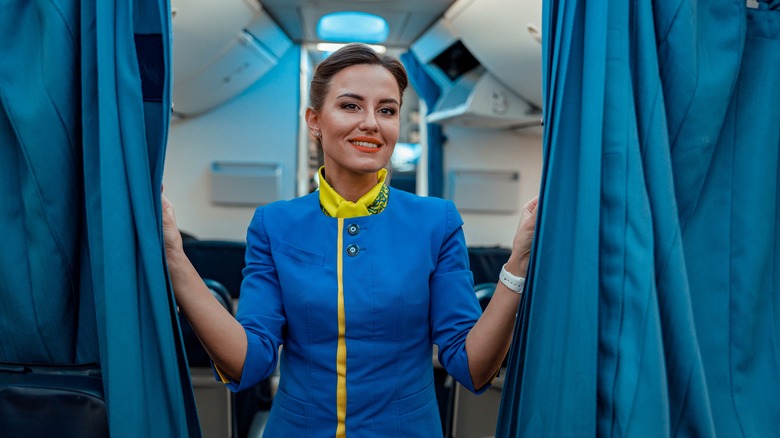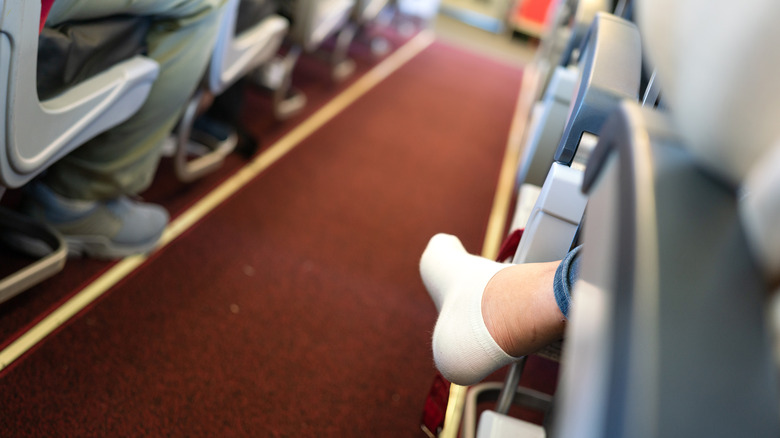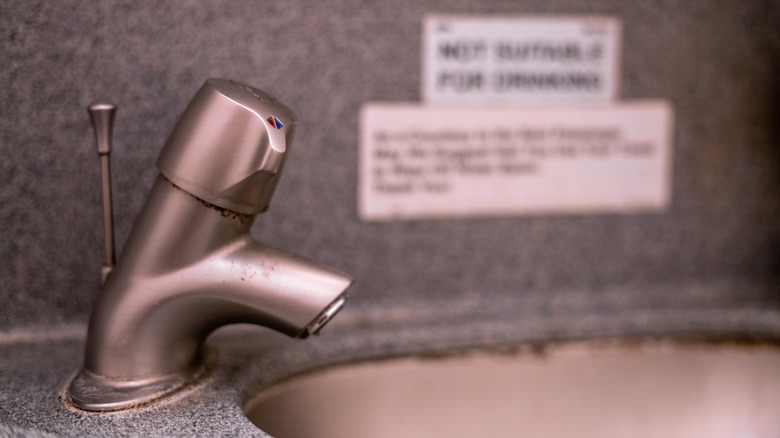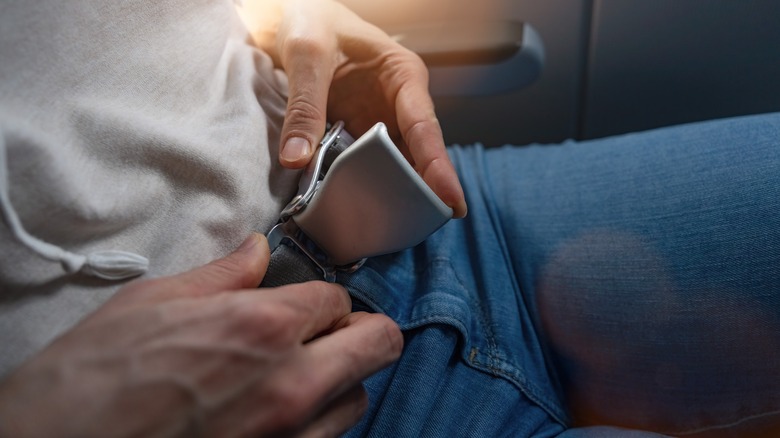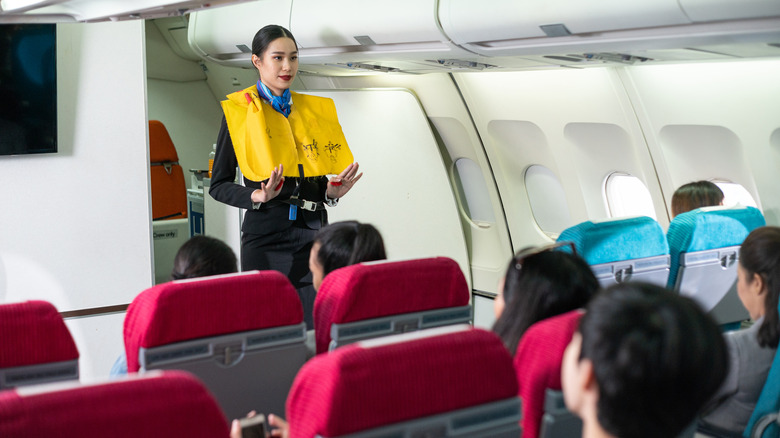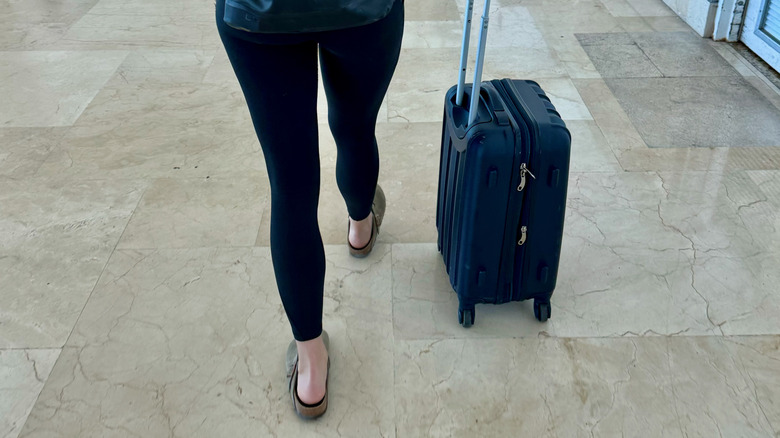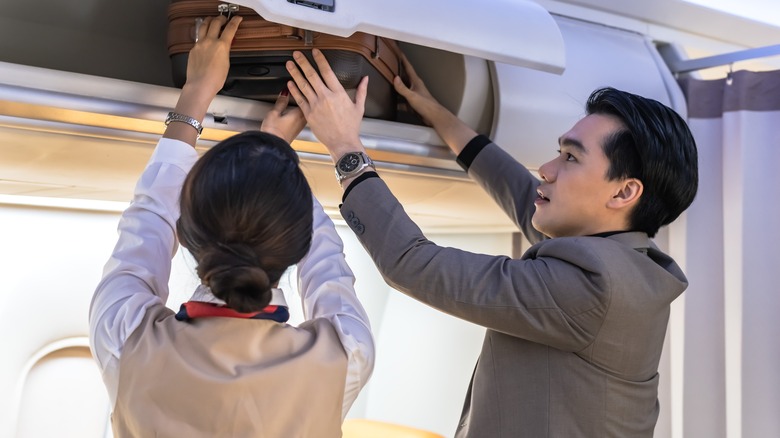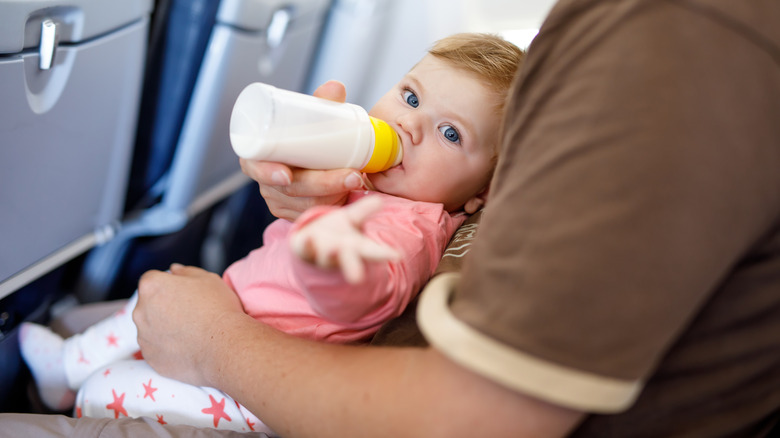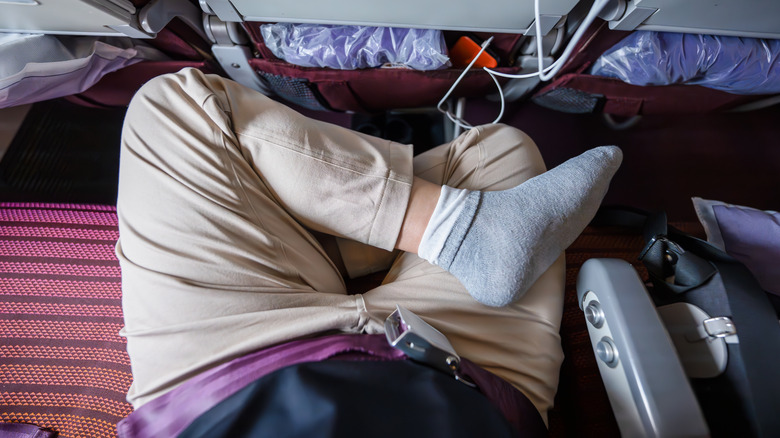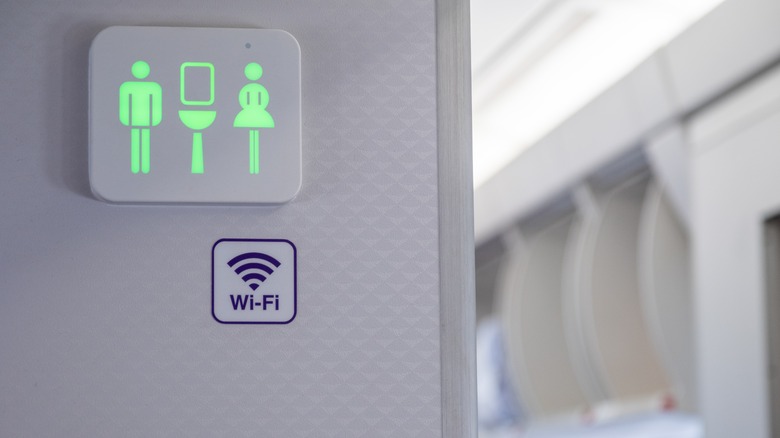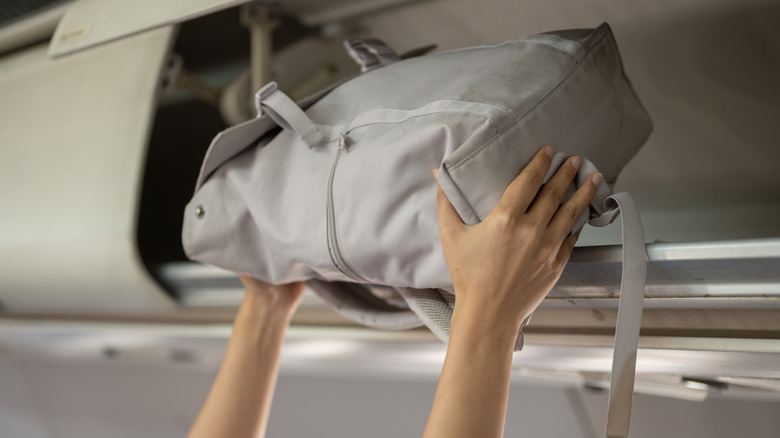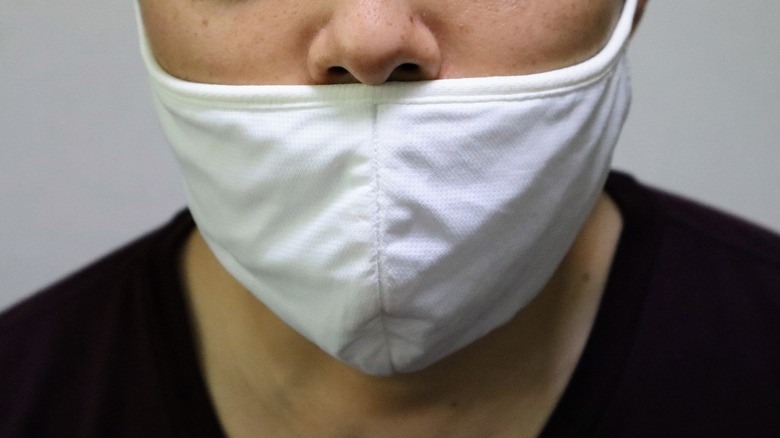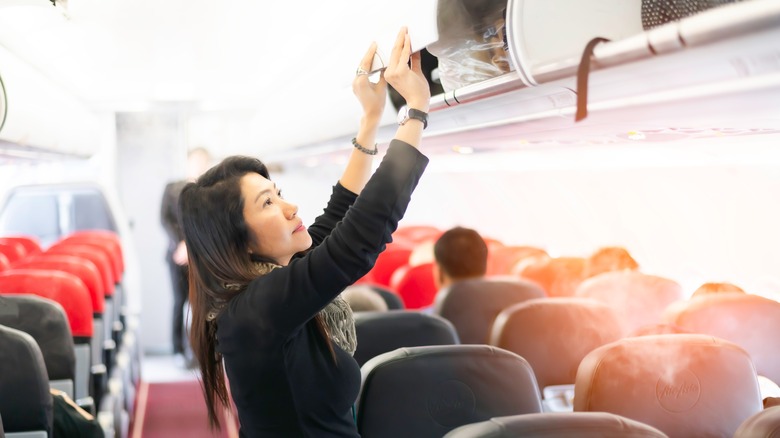Common In-Flight Safety Mistakes Passengers Make Without Realizing It
To some people, boarding a flight is like catching a bus. They do it so often that they think they're pros who know everything there is to know about the dos and don'ts of traveling through the sky. While we're not disputing that experience is valuable and can make a huge difference, there are some common in-flight mistakes that passengers from all walks of life make without even realizing it.
Planes are built with safety in mind and airlines do their best to get travelers from A to B unscathed, but there are some things that everyone should be aware of. From the hidden dangers of plane tap water to the most perilous (and worryingly common) outfit you can wear on a flight, it's time to buckle up and take a few moments to read this important safety briefing. Knowledge is power — and it just might save you from contracting a nasty illness, causing an injury, or much worse.
Walking around without shoes on a long flight
Comfort is key when you're on a long flight, and it's relatively normal to look around the plane and see passengers who have removed their shoes. We tend to shrug this off as just part and parcel of the flying experience — after all, as long as they're not stinky, is it really a problem? While it may not bother other passengers, there's a deceptively simple reason why you should keep your shoes on during the flight, or at least keep them on if you are moving around.
In an article she wrote for Business Insider, former flight attendant Beth Windsor explained, "Some [passengers] even enter the restroom without any socks or shoes. But if the plane hits turbulence when you're in a small restroom, it can cause a mess that you probably don't want to step into, especially not with bare feet." Not many passengers stop to think about the germs they may be picking up as they move around the plane, but there's an easy solution to this. Wear slip-on sandals like Crocs, or invest in a pair of cheap slippers that you can easily put on before heading to the restroom.
Drinking water from the plane tap
Flying can be a thirsty business, especially if you've had a long and tiring journey to the airport in the first place. If the airline doesn't provide complimentary drinks on your flight, then hydrating while in the air can be expensive. Because of this, many passengers bring their own reusable bottles and ask attendants to fill them up from the tap. It's free of charge, but you may end up paying in other ways. Planes have special tanks where water is stored, and while it's an Environmental Protection Agency rule that airlines have to ensure the tanks are cleaned regularly, this doesn't always guarantee that the quality is as good as it should be.
Water on some airlines may be better than others, and it can be easy for bacteria to build up in the tank. Not only is this decidedly icky, but it can also potentially lead to some unpleasant illnesses that will ruin your vacation. To be on the safe side, it's best to buy bottled water before you board. And yes, the water used for tea and coffee also comes from the same tanks, so you might want to rethink that mid-flight hot drink.
Not wearing a seat belt for the duration of the flight
When cruising through the air at 30,000 feet, it's tempting to unbuckle your seat belt, sit back, and enjoy the ride. After all, it's not the same as wearing a seat belt in a car when you're traveling down a highway where risks are all around you, right? In some ways, that theory has merit, but think twice before immediately unfastening your belt at the very first opportunity. Turbulence can happen out of the blue at any given time, and you won't just be jolted forward. The biggest risk is the chance you could be flung upward, hitting your head on the underside of the overhead locker and causing a nasty injury that could even lead to a concussion.
When you're seated, staying buckled up can help avoid you getting any nasty bumps. It often takes a moment for the attendants or pilot to switch the seat belt sign back on and announce turbulence, so do yourself a favor and stay prepared. Let's face it, you can't move around much without one on either, so you may as well put safety first.
Ignoring the safety demonstration
Plenty of new travelers make rookie mistakes as first-time fliers, but there's one habit you should always stick to, no matter how many times you've boarded a plane ahead of an exciting adventure. You could have been on 10,000 flights and think you know everything there is to know about what to do in an emergency, but you should always listen to the safety briefing before takeoff. Many people are guilty of assuming that there is little they could do in case of an emergency and opt to keep their headphones in while the demonstration is happening.
However, not all airplane-related disasters come from crashes and explosions. There are plenty of things that can go wrong when survival depends on passengers knowing what to do. Plus, some of the information — such as the location and number of emergency exits — can change depending on what type of plane you're traveling on. Do yourself a favor and pay attention, as it could be the difference between life and death in a dire situation.
Wearing leggings presents a terrible risk
Figuring out what to wear for a long day of traveling can be difficult, but there are some things you should never wear on a plane, no matter how comfortable they are. On any given flight, it's highly likely that you'll spot at least one traveler wearing a pair of leggings. At first glance, it makes perfect sense. They are stretchy, comfortable, and don't take up much room in a suitcase. However, wearing leggings presents a serious safety issue that many passengers might not be aware of.
As travel writer Christine Negroni told Sun Online Travel, "You might have to escape through a cabin fire or there could be a separate fire on the ground once you leave the aircraft. Everyone is wearing yoga pants on planes now, but I avoid all artificial fibers because they are more likely to burn and stick to you if there is a fire." Many non-catastrophic incidents on planes can involve fires, so give yourself the best chance of escaping by sticking to materials like cotton. Ignore the advice, and you could end up with burns that will scar you for life — or much worse.
Drinking too much alcohol
As popular as it seems to be, the bad news is that you should think twice before drinking alcohol at the airport. If you're headed out on vacation, it's common to have a celebratory drink in the lounge or at a bar, but that can often lead to more drinks on the plane. Even those with a high tolerance for alcohol may find themselves feeling a little too lit when they're in the air. Not only can this mean that you won't function properly during an emergency, but it can be difficult for your body to handle on a physical level. In a study published in 2024 (reported in the New York Times), it was determined that taking a nap on a plane after drinking alcohol can reduce your blood oxygen levels and put your heart under undue pressure.
If you're fighting fit with no other health issues, you probably won't get seriously ill and may just wake up feeling groggier than normal. However, if you're older or have pre-existing medical conditions, the combination of alcohol and cabin pressure could potentially have serious repercussions that require medical attention. That's not a position anyone wants to be in when they're up in the clouds.
Overpacking hand luggage to save money on checked bags
Waiting around for their luggage after a flight isn't the most enjoyable part of traveling. It can be tiresome, especially if there are delays, and that's if it doesn't get lost. These days, more and more people are flying with only cabin luggage to save time and money, and there's a lot to be said for only packing a carry-on for a week-long vacation. After all, while there are often size limitations on hand luggage, there are rarely weight limitations. This can seem like a great perk, but before you start packing all of your heaviest shoes and jewelry, take a minute to consider the risks. Putting heavy hand luggage in the overhead lockers can be challenging, and if you lose your grip, it could easily cause serious injury to yourself or a fellow passenger.
Furthermore, lockers can sometimes pop open due to turbulence, and no one wants a suitcase weighing 55 pounds flying at them across the cabin. Even if you don't have a lot of stuff, if your luggage is particularly heavy, you should consider paying for a checked bag. It's not just about your safety on the flight, but also the safety of the crew and other passengers.
Flying with a baby on your lap
A lot of airlines let children under 2 years old fly without having to pay for a seat, as they're small enough to sit in the lap of a paying adult. This can seem like a huge bonus and often makes an expensive trip a little more affordable for young families. While those perks are hard to deny, it doesn't mean it's the safest way to travel. President of the Association of Flight Attendants-CWA Sara Nelson told Conde Nast Traveler in 2025, "As we've seen with accidents this year, it is critical that every passenger has their own seat belt to be safe in the cabin when an incident occurs from turbulence to a crash landing that turns the aircraft upside down."
Though parents may think that they would keep a tight grip on their precious babies during an emergency, it's simply not always possible. Former airline pilot Shawn Pruchnicki told the publication that non-fatal aircraft accidents like hard landings or planes running off the runway can and do happen: "If we look back historically, we find that in those very survivable accidents, the only injuries quite frequently are to babes in arms."
Crossing your legs
If you're one of the lucky passengers with a stature that means you can move your legs around a little during the flight, then it can be second nature to cross your legs to get more comfortable. However, we have more bad news. While most of us know that flying can cause blood clots, there is more to it than just getting up and walking around every now and then. Crossing your legs could make matters much worse, according to Dr. Neena Chandrasekaran, who took to TikTok to share her knowledge.
"The barometric pressure induces an inflammatory state within our bodies that can lead to clots, especially in our legs," she explained. "If your legs are crossed, that allows for more blood to pool, with your veins being pressed against each other. This significantly raises the risk of developing a blood clot." If you're particularly worried about clotting, make sure that you're getting up at regular intervals and staying hydrated, and perhaps consider investing in a pair of compression socks.
Flushing things you shouldn't down the toilet
Understandably, there are plenty of things flight attendants know about airplane bathrooms that you don't. For instance, you may think that you could put most anything down the toilet and have it shot directly out into the atmosphere, but that isn't the case. Planes have waste disposal systems, and flushing anything other than human waste down them can cause serious issues. In March 2025, an Air India flight traveling from Chicago's O'Hare Airport to Delhi had to turn around when passengers clogged over half of the plane's toilets by flushing clothing, rags, and other items.
Interestingly, this wasn't a lone incident. "Our teams have previously also found objects such as blankets, innerwear, and diapers, among other waste, having been flushed down the toilets on other flights," a representative for Air India explained via the New York Post. Not only is this incredibly unsanitary and a health and safety hazard, but unplanned reroutes can cause the pilots and staff undue stress, as well as the other passengers on board.
Going back for belongings in an emergency
No matter the emergency, you are always told not to go back and collect your belongings. It could be a house fire, a fire drill, or something else, but spending time grabbing your stuff can be the difference between life and death. Though it may sound like common sense, you would be surprised how many passengers don't abide by this standard safety rule during airplane emergencies. In March 2025, an American Airlines flight was forced to make an emergency landing at Denver Airport and erupted into flames with passengers still on board.
Amazingly, photos from the scene showed evacuated passengers standing on the wing of the plane, some of whom had their luggage with them. By some miracle, there were no fatalities during this incident, but 12 travelers were taken to hospital for their injuries. If you ever find yourself in a situation like this, ditch your stuff and evacuate as soon as possible. Things can be replaced, but you only have one life.
Wearing masks incorrectly
Masks were mandatory on many airlines during the COVID-19 pandemic that spread across the world in 2020, and for good reason. The deadly virus spread incredibly quickly and made a lot of people think about their health and whether they should be protecting themselves in close-knit situations post-pandemic. Some travelers have opted to keep wearing masks to evade any illnesses, but a lot of people don't wear them correctly. Airplanes can be hotbeds for airborne germs, but wearing a mask that isn't covering your nose or mouth properly is about as much use as a paper bag in a storm.
If you are anxious about catching any bugs on your trip, we highly recommend that you ditch cloth masks (yes, even the ones with pretty patterns) and stick with surgical masks. Cloth masks may feel more comfortable, but the level of protection they offer is significantly lower. With that being said, the surgical mask should also fit snugly around the face and not gape to do its job properly — another common mistake that people may not realize they're making.
Getting possesions out of the overhead locker
In the chaos of boarding a plane, many people forget to take something they need for the flight out of their luggage stored in the overhead locker. You're guaranteed to see at least one person getting out of their seat to rummage in their bags over the course of the flight, but this is more dangerous than some people may realize. Moving the luggage around while standing could be an issue if turbulence hits, causing objects to fall from the lockers and onto unsuspecting passengers. Furthermore, it blocks the aisle and can also be a problem while boarding, according to Bae Lee, a flight attendant who spoke to Explore.
"[Passengers] might hold up boarding while standing in the aisle. They'll take 18 minutes just to get everything out of their backpacks before they put it in the overhead bin," she said. "Small items belong under the seat, but you can get everything out of your bag while standing in front of your seat. Please do so out of the aisle rather than in the aisle." When travelers do this at the start of the flight, it means attendants can't get everyone easily and safely boarded. Blocking the aisle because of poor organization during the flight also means they aren't able to reach other passengers quickly if they need to.
